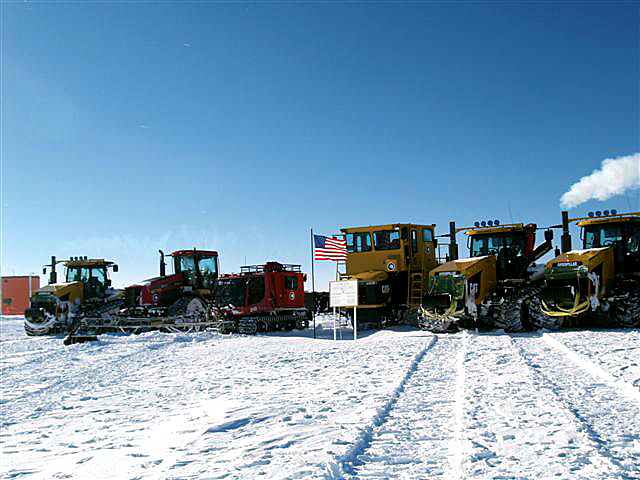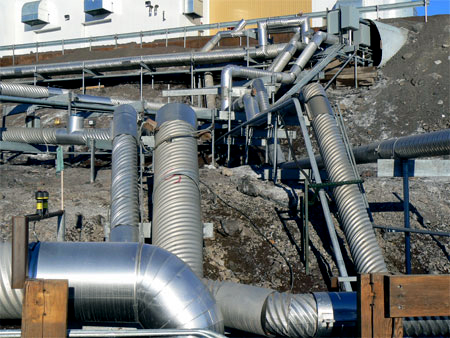Stimulus moneyNSF allocates $18.5 million in ARRA funds for transportation, infrastructurePosted September 11, 2009
The American Recovery and Reinvestment Act of 2009 (ARRA) The National Science Foundation (NSF) Nearly half of the ARRA money, about $7.5 million, will purchase new equipment for the South Pole Traverse, an overland tractor train that transports fuel and supplies on a snow-compacted route between the McMurdo and South Pole The traverse uses Case and Caterpillar tractors, which pull specially designed sleds loaded with fuel, along with other cargo and a sleeping/cooking module. A 10-person team spends months in the field on these re-supply missions, traveling across an icescape that requires crossing crevassed ice shelves and moving glaciers. This method saves fuel and the associated carbon footprint over using large, ski-equipped airplanes flown by the New York Air National Guard An additional $3 million will buy materials for a “scientific traverse” — equipment somewhat similar to the South Pole Traverse, but with the intent of supporting a major scientific campaign in the coming years, with modules for labs, ice-core drilling and other scientific equipment. Another $3 million will pay for a new McMurdo Station heat-trace system, an electrical system that carries heat along the length of a plumbing system to keep the water from freezing in the pipes — an obvious concern in Antarctica. The current system is not very efficient because there is no way to regulate it, so it remains on all the time, according to Mike St. Jean, RPSC Life Cycle manager. The plan is to install a thermostatically controlled system along six miles of pipeline, as well as replace nearly half a mile of pipe. St. Jean said the new system would be roughly 40 percent more efficient, saving the NSF about $300,000 a year in energy costs. The one-year project will employ 21 people during the summer field season, which runs from October to mid-February, and 18 people during the winter season. Some of those hired for the project will work both seasons, so it is unclear at this time how many people the project will ultimately employ. “We’re not only giving a [U.S.] design firm some work, but we’ll have a dedicated crew working on the pipeline,” St. Jean said. Finally, $5 million will be invested in new airfield vehicles ($3.3 million) for transporting cargo and people, and emergency vehicles and fire suppression equipment ($1.7 million), including two new ambulances. A number of RPSC employees are busily reviewing the bid packages for the various projects, with hopes of getting as many materials as possible on the re-supply vessel that steams down every year to McMurdo Station, the main logistics hub and research facility of the USAP. Said Sam Feola, RPSC Program Director, “We will accomplish the objective of the ARRA funds by pumping $18.5 million into the U.S. economy, thus creating jobs and helping American companies survive these difficult economic times.” The NSF's first major award |



For USAP Participants |
For The Public |
For Researchers and EducatorsContact UsU.S. National Science FoundationOffice of Polar Programs Geosciences Directorate 2415 Eisenhower Avenue, Suite W7100 Alexandria, VA 22314 Sign up for the NSF Office of Polar Programs newsletter and events. Feedback Form |



